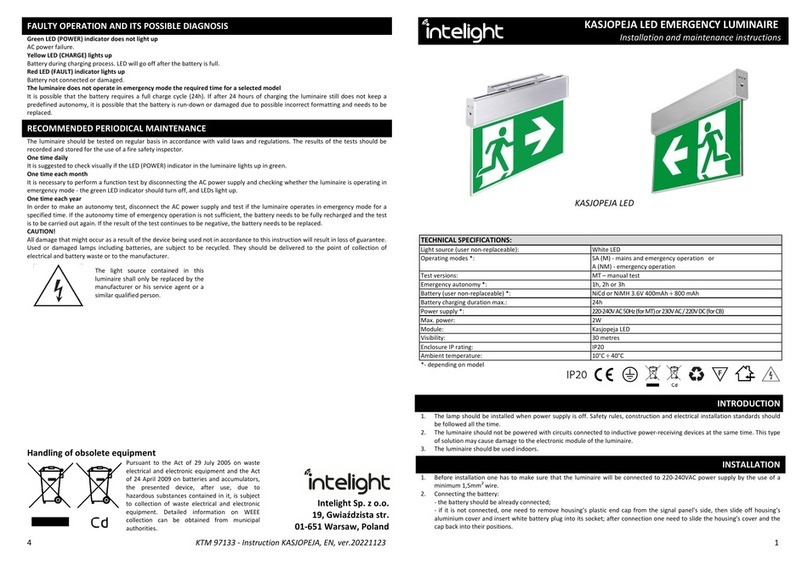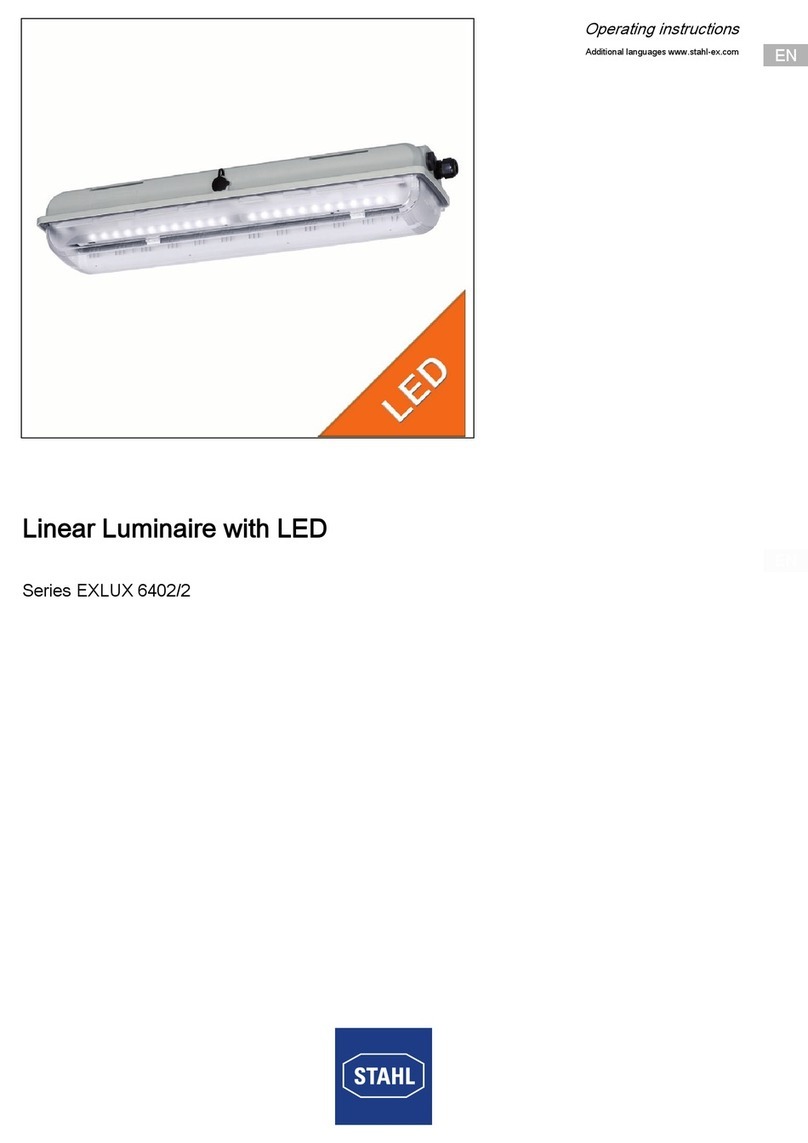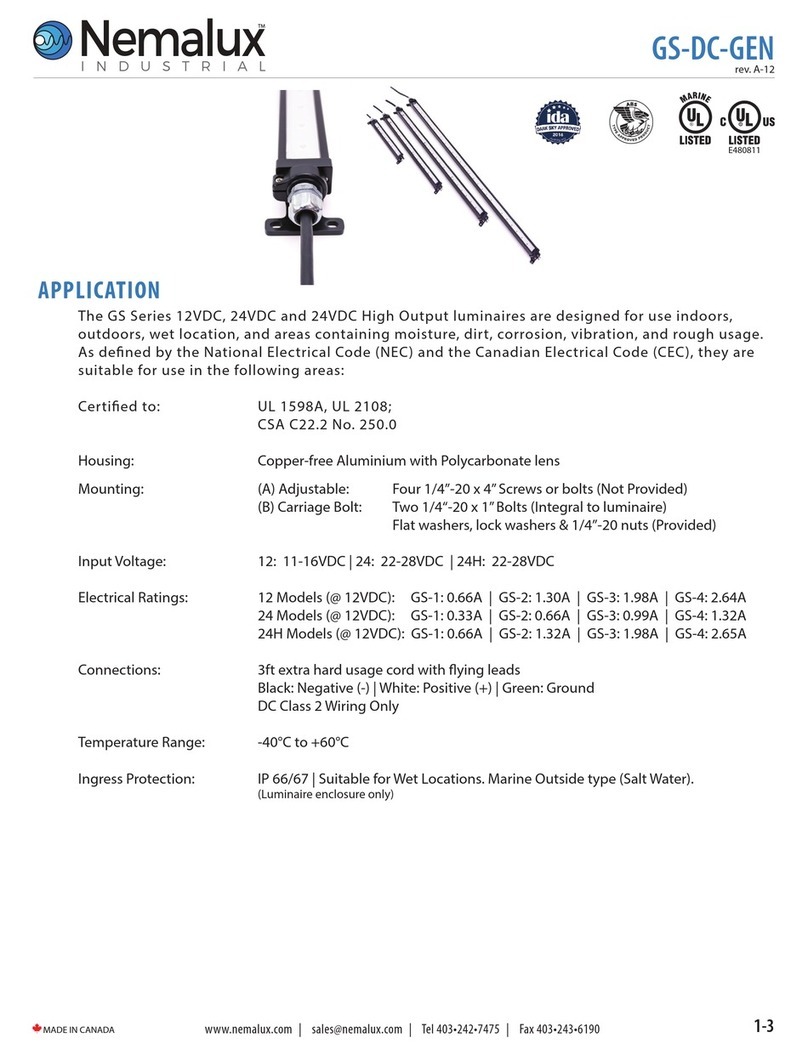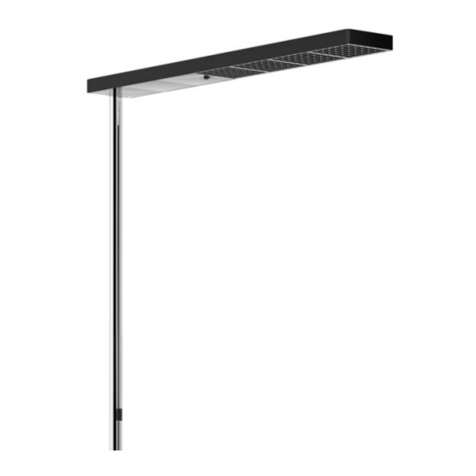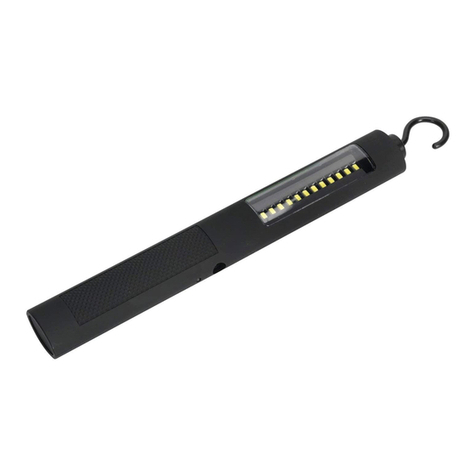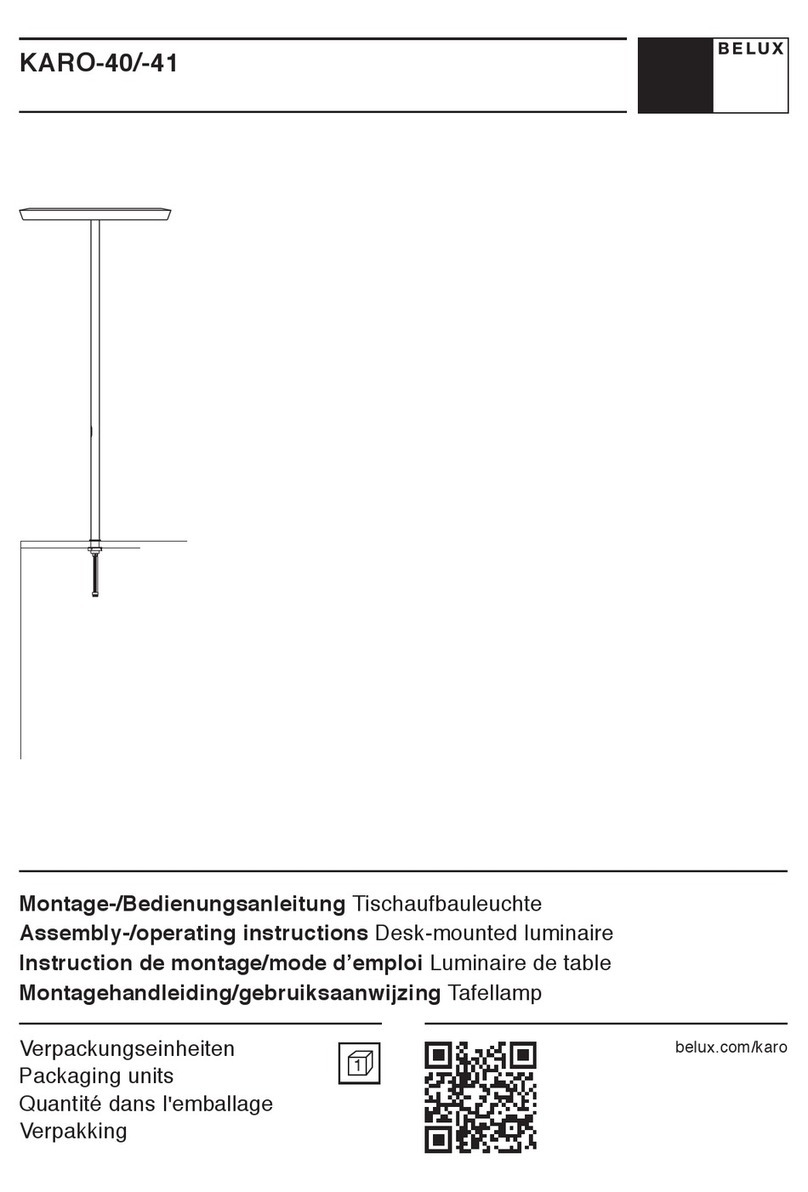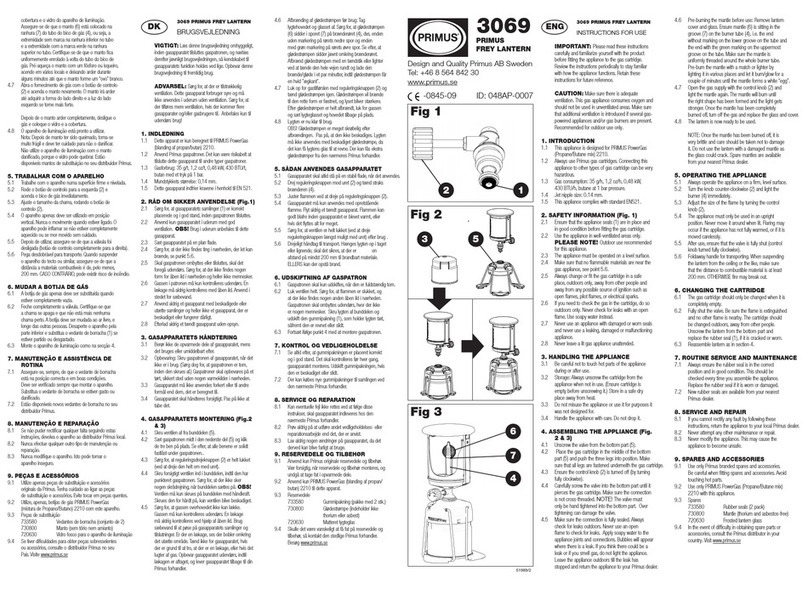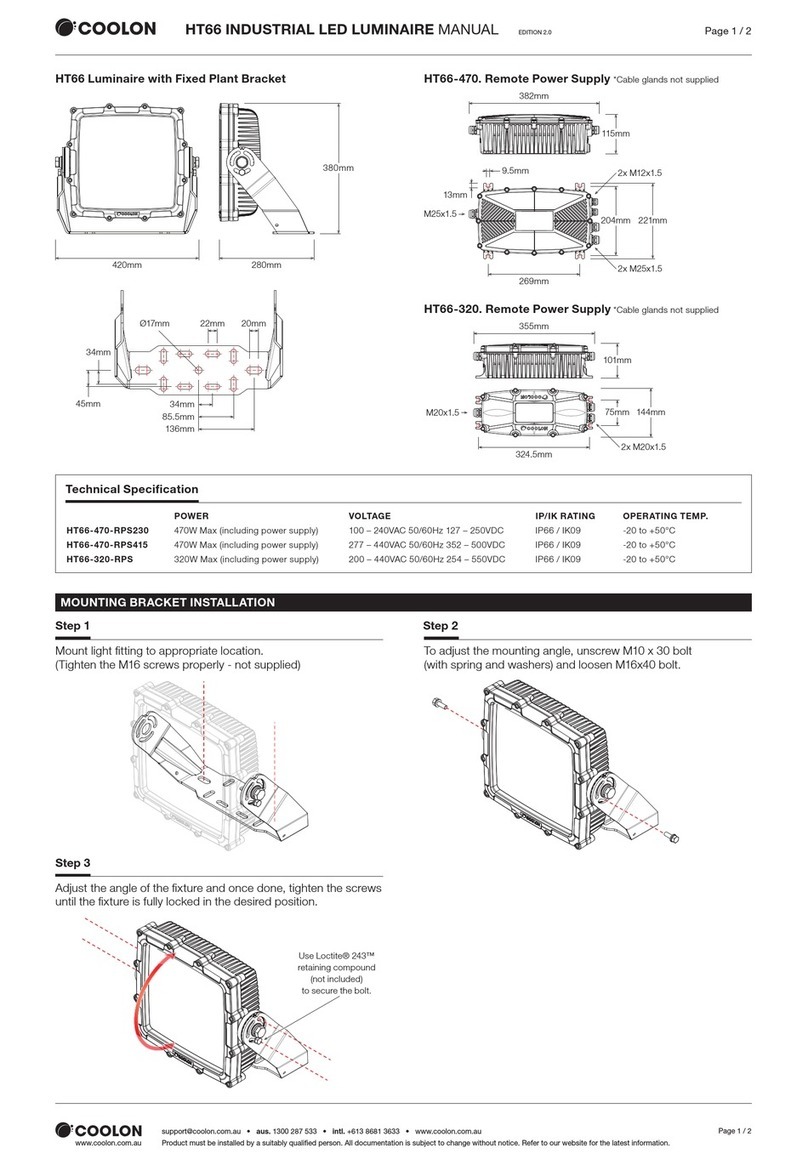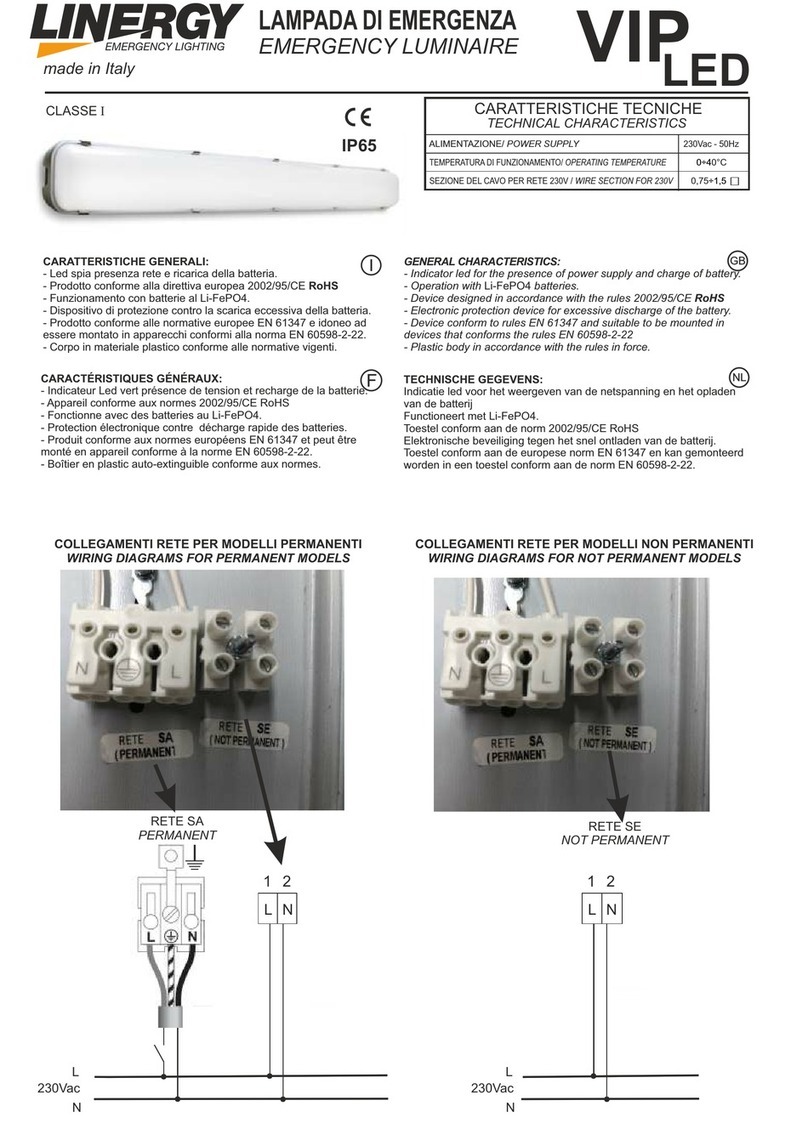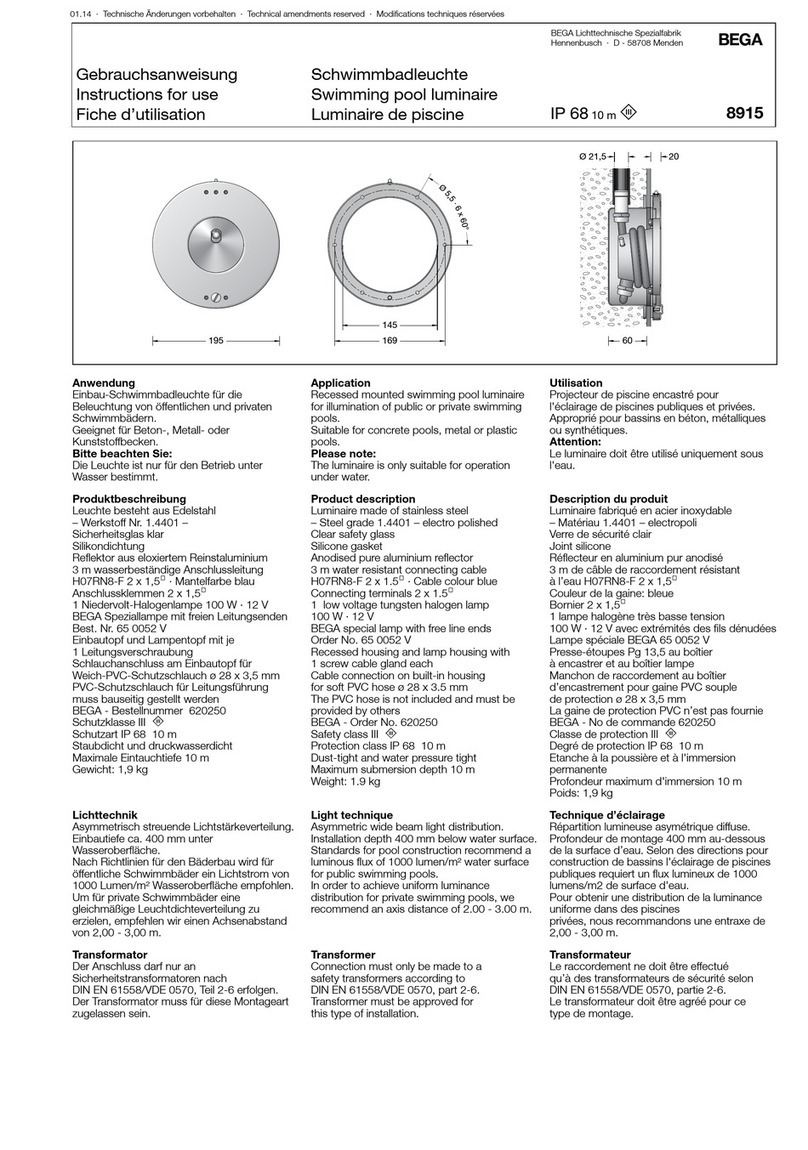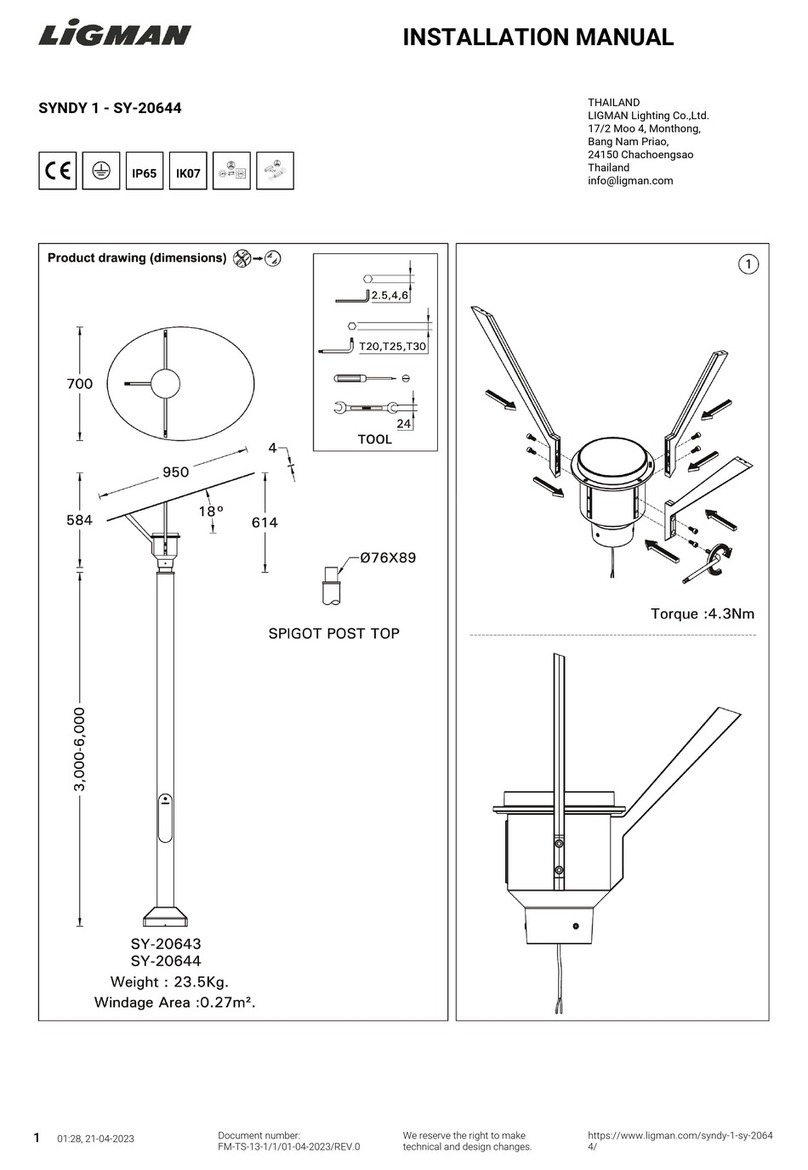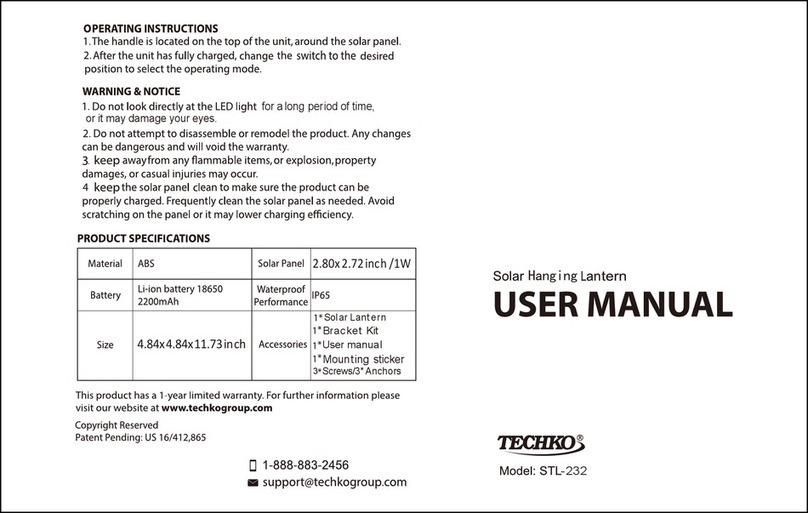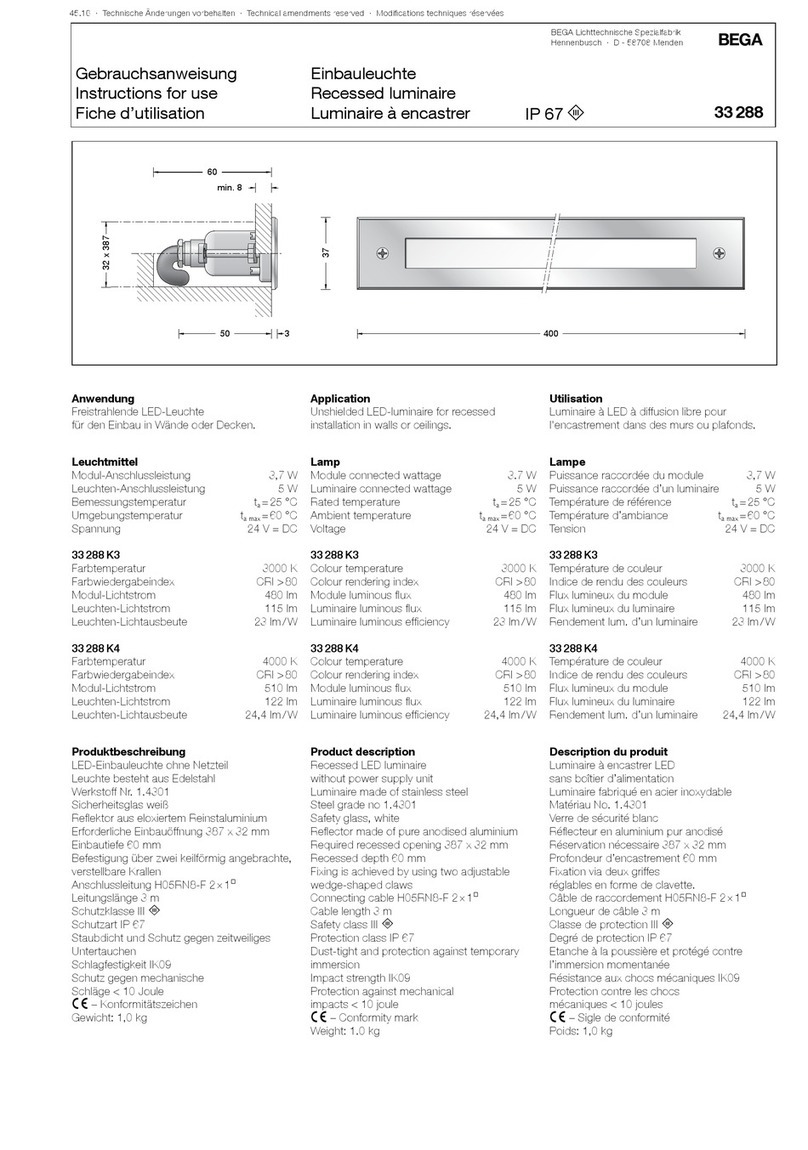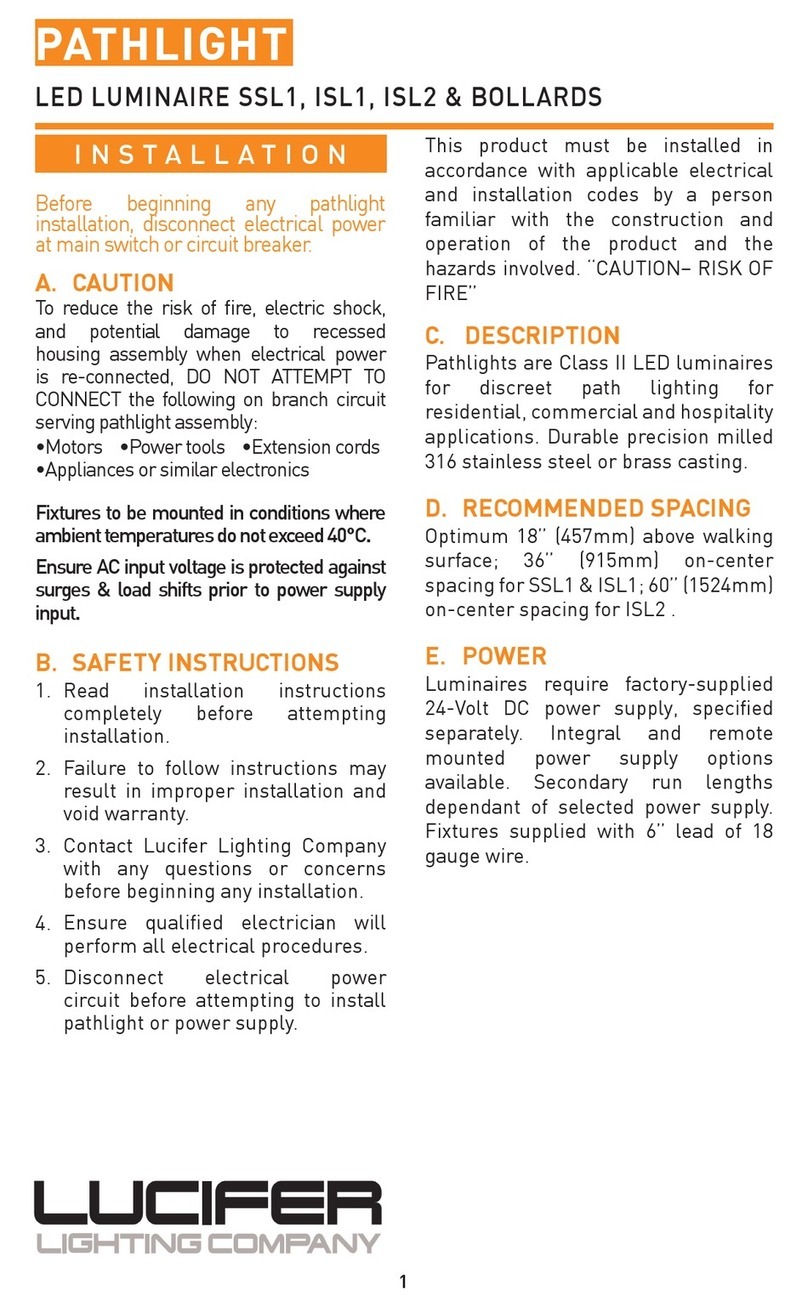Intelight ORION LED User manual

4 1
FAULTY OPERATION AND ITS POSSIBLE DIAGNOSIS
LED indicator does not light u
AC power failure or the battery not connected or damaged.
The luminaire does not o erate in emergency mode the required time for a selected model
It is possible that the battery requires a full charge cycle (48h). If after 48 hours of charging the luminaire still does
not keep a predefined autonomy it is possible that the battery is run-down or damaged due to possible incorrect
formatting and needs to be replaced.
RECOMMENDED PERIODICAL MAINTENANCE
The luminaire should be tested on regular basis in accordance with valid laws and regulations. The results of the
tests should be recorded and stored for the use of a fire safety inspector.
One time daily
It is suggested to check visually if the LED indicator in the luminaire lights up in green.
One time each month
It is necessary to perform a function test by disconnecting the AC power supply and checking whether the
luminaire is operating in emergency mode - the green LED indicator should turn off and LEDs light up.
One time each year
In order to make an autonomy test disconnect the AC power supply and test if the luminaire operates in
emergency mode for a specified time. If the autonomy time of emergency operation is not sufficient the battery
needs to be fully recharged and the test is to be carried out again. If the result of the test continues to be negative
the battery needs to be replaced.
CAUTION!
All damage that might occur as a result of the device being used not in accordance to this instruction will result in
loss of guarantee.
Used or damaged lamps including batteries are subject to be recycled. They should be delivered to the point of
collection of electrical and battery waste or to the manufacturer.
Handling of obsolete equi ment
Pursuant to the Act of 29 July 2005 on
waste electrical and electronic
equipment and the Act of 24 April 2009
on batteries and accumulators the
presented device after use due to
hazardous substances contained in it is
subject to collection of waste electrical
and electronic equipment. Detailed
information on WEEE collection can be
obtained from municipal authorities.
Intelight S . z o.o.
8, Rydygiera str.
01 -793 Warsaw, Poland
KTM 9714
5
-
Instru
ction
ORION LED,
EN, ver.20170
0
2
ORION LED EMERGENCY LUMINAIRE
Installation and maintenance instructions
ORION LED 4W ORION LED 7W
OV
TECHNICAL SPECIFICATIONS:
Light
source
*
:
(replaceability: 4W – replaceable; 7W – non-replaceable)
Version 4W: 10 x LED ; Version 7W: 41 x LED
Operating modes
*
:
SA
-
mains and emergency operation
(M)
or
A - emergency operation (NM)
Test versions
*
:
MT
–
manual test
or
AT – auto test
Emergency
autonomy
*
:
1 hour or 3 hours
Battery
(
replaceable
)
*
:
Version 4W:
Ni
-
Mh 1800 mAh / 3.6 V
o
r
Ni - Cd 4500 mAh / 2.4V
Ni - Cd 1800 mAh / 3.6V
Version 7W: Ni-Cd 1500 mAh / 3.6V
Battery charging duration:
2
4
h
Power supply:
220
-
240V AC 50Hz
Enclosure IP rating:
IP65
*
-
depending on model
INTRODUCTION
1. The lamp should be installed when power supply is off. Safety rules construction and electrical installation
standards should be followed all the time.
2. The luminaire should not be powered with circuits connected to inductive power-receiving devices at the
same time. This type of solution may cause damage to the electronic module of the luminaire.
3. The luminaire should be used indoors.
INSTALLATION
1. Before installation one has to make sure that the luminaire will be connected to 220-240VAC power supply by
the use of minimum a 1 5mm2 wire.
2. Open the luminaire by unscrewing two screws on its ends. Remove the cover.
3. Open the reflector plate with LED light source either by unscrewing two screws at indicated points (for Orion
LED) or releasing two plastic locks (Orion LED 7W). Leave it on hinges.
4. Cut out an opening in the body for power supply wires. When making openings in the body bear in mind the
IP rating of the body and use appropriate sealing afterwards. It is necessary to use either grommets or cable
glands to maintain IP65 protection level.
5. Install the body of the luminaire on the wall or ceiling making the information label visible for people who will
carry out testing in future.

2 3
6. Prepare power cable and connect all the wires to the appropriate terminal block entries.
7. The description of luminaire terminals:
L - phase wire - brown or black insulation colour; power source for Maintained operation and battery charging
N - neutral wire - blue insulation colour
PE - earth wire - yellow and green insulation colour
8. EMERGENCY OPERATION. To enable emergency operation of the luminaire the AC mains power has to be
connected to appropriate terminals L (phase) and N (neutral). Always remember about connecting the
protection earth wire (PE). The luminaire should be constantly supplied by power - voltage drop will result in
emergency mode activation.
9. MAINS AND EMERGENCY OPERATION. For the mains and emergency mode of the luminaire the AC mains
supply needs to be connected to relevant terminals: L (phase) and N (neutral). Always remember about
connecting the protection earth wire (PE). In addition a jumper must be installed between ZW1 and ZW2
terminals (for version 4W) or between L and L1 terminals (for version 7W and some 4W) or between L and
ZW1 terminals (for some 4W versions). Phase loss L will cause automatic activation of the emergency mode.
Replacing the jumper by a switch enables to use the luminaire also as a part of a basic lighting.
10. Please remember to indicate the date of installation on the label attached to the battery pack.
11. Insert the battery plug into the socket on the PCB.
12. Close the reflector/LED plate and fix it to the body using either screws or locks depending on model.
13. Install the diffuser and screw it to the body.
14. For quick operation testing – switch on the AC power supply. The green LED indicator should light up signaling
the battery charging.
15. First-time charge of the luminaire battery pack should be carried out continuously for 48 hours. This will allow
appropriate formatting of the battery pack. During the first-time charge no testing should be carried out and
power supply should not be disconnected for any other purpose. Power supply should be disconnected after
48 hours for the first time. The luminaire should complete a full emergency operation cycle after which it
should be connected to power supply for another 36 hours. This sequence shall complete the formatting cycle.
OPERATION
Emergency o eration mode
In this mode (A / NM) the luminaire does not light when powered by AC supply voltage. Correct operation of the
device is confirmed by LED indicator lighting up in green. The battery is being continuously trickle charged for the
purpose of a possible emergency operation. When AC power supply is off the luminaire automatically starts
operating in emergency mode and the source of light is activated for the period specific for a particular model.
Mains and emergency o eration mode
In this mode (SA / M) the luminaire lights up when powered by AC supply voltage. Correct operation of the
device is also confirmed by LED indicator lighting up in green. The battery is being continuously trickle charged for
the purpose of possible emergency operation. When AC power supply is off the luminaire automatically starts
operating in emergency mode and the source of light is activated for the period specific for a particular model.
Information on lam o eration
The luminaire operates correctly and charging circuit works if the LED indicator lights up in green. If the indicator
does not light up the lamp is not operating with AC power supply on or the battery has been damaged. See more
info about signaling in “TESTING” section.
Battery ack
The luminaire is equipped with a rechargeable Ni-Cd or Ni-MH battery pack. Please remember to carry out the
correct first-time charge cycle. After such a formatting cycle it achieves its capacity and is prepared to perform a
possible full time emergency operation. It is recommended to replace the battery once every four years of
operation or in a case of poor test results. Obsolete batteries similarly to packaging fluorescent lamps or
electronics are recyclable products that should be disposed to a recyclable waste collection point.
TESTING
ORION LED luminaire is equipped with a TEST button which is being used both for MT – manual test versions and
AT – auto test versions. It enables to test emergency operation of the luminaire.
Auto test function
If a luminaire version has an auto test functionality the TEST button is being used to initiate and break either
function or autonomy tests depending on time of pressing. Pressing the button for 2s<t<5s initiate the function
test for 5s<t<10s – initiate the autonomy test while for t>10s – breaks any currently running test.
In a standard luminaire operation both functional and autonomy tests are being initialised automatically function
test every 30 days and autonomy test every 360 days.
All the possible luminaire working states and LED indications are gathered in the table below.
Legend:
T – 2s period; t – time of pressing the test button
FLASHING: (1/T) / (2/T) / (3/T) – 1 flash / 2 flashes / 3 flashes every 2s period
FLASHING (A): alternate flashing of two LEDs – with a ½ T shift between them
FLASHING (D): number of flashes depending on battery charge status: 1/T ≥ 25% 2/T ≥ 50% 3/T ≥ 75% ON ≥ 90%
(here ON means the green LED is continually lighting the battery is being trickle charged).
Manual test function
When the emergency luminaire is connected to mains and there is no voltage drop pressing and holding TEST
button will result in activation of the “voltage drop” mode the signal LED will go off and the luminaire should light
up. When the button is released - the luminaire will switch back into its standard operation mode.
The above action means that in a case of emergency mode version the luminaire will go from unlit to illuminated.
In a case of mains and emergency mode the luminaire will change a power source from mains to a battery supply
the switch-over moment should be visible as a quick blink – during a very short while the light source will be off.
CAUTION! In a case of SA (M) luminaire version but wired as A (NM) one the lamp behaves according to A (NM)
typical behaviour.
Other Intelight Lantern manuals
